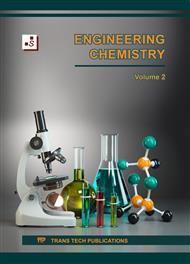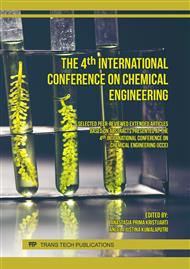[1]
X. Jiang, L. Zhao, Y. Cheng, S. Wei, and Y. Jin, "Optimal configuration of electric vehicles for charging stations under the fast power supplement mode," J. Energy Storage, vol. 45, p.103677, Jan. 2022.
DOI: 10.1016/J.EST.2021.103677
Google Scholar
[2]
A. M. Abioye and F. N. Ani, "High Performance Supercapacitor Based on Activated Carbon Electrodes Prepared Using Microwave Temperature as Process Parameter," p.90–95, Dec. 2020.
DOI: 10.2991/AER.K.201221.017
Google Scholar
[3]
J. Zhang, L. Gong, K. Sun, J. Jiang, and X. Zhang, "Preparation of activated carbon from waste Camellia oleifera shell for supercapacitor application," J. Solid State Electrochem. 2012 166, vol. 16, no. 6, p.2179–2186, Jan. 2012.
DOI: 10.1007/S10008-012-1639-1
Google Scholar
[4]
Y. F. Ferawati and R. F. Susanti, "The Role of N-Doping to The Pore Characteristics of Activated Carbon from Vetiver Root Distillation Waste," Metalurgi, vol. 36, no. 2, p.59–68, Sep. 2021.
DOI: 10.14203/METALURGI.V36I2.595
Google Scholar
[5]
Z. Xiao, W. Chen, K. Liu, P. Cui, and D. Zhan, "Porous biomass carbon derived from peanut shells as electrode materials with enhanced electrochemical performance for supercapacitors," Int. J. Electrochem. Sci., vol. 13, no. 6, p.5370–5381, Jun. 2018.
DOI: 10.20964/2018.06.54
Google Scholar
[6]
Y. Li and X. Liu, "Activated carbon/ZnO composites prepared using hydrochars as intermediate and their electrochemical performance in supercapacitor," Mater. Chem. Phys., vol. 148, no. 1–2, p.380–386, Nov. 2014.
DOI: 10.1016/J.MATCHEMPHYS.2014.07.058
Google Scholar
[7]
R. Chaudhary et al., "Removal of Oil and Grease in Wastewater using Palm Kernel Shell Activated Carbon," IOP Conf. Ser. Earth Environ. Sci., vol. 549, no. 1, p.012064, Aug. 2020.
DOI: 10.1088/1755-1315/549/1/012064
Google Scholar
[8]
A. Nugroho et al., "Synthesis and Characterization NS-Reduced Graphene Oxide Hydrogel and Its Electrochemical Properties," Lett. Mater., vol. 12, no. 2, p.169–174, 2022.
DOI: 10.22226/2410-3535-2022-2-169-174
Google Scholar
[9]
A. N. A. El-Hendawy, "An insight into the KOH activation mechanism through the production of microporous activated carbon for the removal of Pb2+ cations," Appl. Surf. Sci., vol. 255, no. 6, p.3723–3730, Jan. 2009.
DOI: 10.1016/J.APSUSC.2008.10.034
Google Scholar
[10]
R. F. Susanti, R. G. R. Wiratmadja, H. Kristianto, A. A. Arie, and A. Nugroho, "Synthesis of high surface area activated carbon derived from cocoa pods husk by hydrothermal carbonization and chemical activation using zinc chloride as activating agent," Mater. Today Proc., 2022.
DOI: 10.1016/j.matpr.2022.01.042
Google Scholar
[11]
M. Danish et al., "Comparison of surface properties of wood biomass activated carbons and their application against rhodamine B and methylene blue dye," Surfaces and Interfaces, vol. 11, p.1–13, Jun. 2018.
DOI: 10.1016/J.SURFIN.2018.02.001
Google Scholar
[12]
R. F. Susanti, A. A. Arie, H. Kristianto, M. Erico, G. Kevin, and H. Devianto, "Activated carbon from citric acid catalyzed hydrothermal carbonization and chemical activation of salacca peel as potential electrode for lithium ion capacitor's cathode," Ionics 2019 258, vol. 25, no. 8, p.3915–3925, Feb. 2019.
DOI: 10.1007/S11581-019-02904-X
Google Scholar
[13]
K. Byrappa et al., "Impregnation of ZnO onto activated carbon under hydrothermal conditions and its photocatalytic properties," J. Mater. Sci. 2006 415, vol. 41, no. 5, p.1355–1362, Mar. 2006.
DOI: 10.1007/S10853-006-7341-X
Google Scholar
[14]
A. Nugroho, E. B. Nursanto, S. A. Pradanawati, H. S. Oktaviano, H. Nilasary, and H. Nursukatmo, "Fe based catalysts for petroleum coke graphitization for Lithium Ion battery application," Mater. Lett., vol. 303, p.130557, 2021.
DOI: 10.1016/j.matlet.2021.130557
Google Scholar
[15]
D. Saramas and S. Ekgasit, "Nano-Zinc Oxide-Doped Activated Carbon from Popped Rice and Its Application for Feed Additive," Eng. J., vol. 25, no. 3, p.41–50, Mar. 2021.
DOI: 10.4186/ej.2021.25.3.41
Google Scholar
[16]
S. Ahmed, A. Ahmed, and M. Rafat, "Supercapacitor performance of activated carbon derived from rotten carrot in aqueous, organic and ionic liquid based electrolytes," J. Saudi Chem. Soc., vol. 22, no. 8, p.993–1002, Dec. 2018.
DOI: 10.1016/J.JSCS.2018.03.002
Google Scholar
[17]
A. M. Aljeboree and A. B. Mahdi, "Synthesis highly active surface of ZnO/AC nanocomposite for removal of pollutants from aqueous solutions: thermodynamic and kinetic study," Appl. Nanosci., 2021.
DOI: 10.1007/s13204-021-01946-w
Google Scholar
[18]
S. Xiong et al., "Hydrothermal synthesis of high specific capacitance electrode material using porous bagasse biomass carbon hosting MnO2 nanospheres," Biomass Convers. Biorefinery 2019 114, vol. 11, no. 4, p.1325–1334, Nov. 2019.
DOI: 10.1007/S13399-019-00525-Y
Google Scholar
[19]
Y. Wang et al., "Recent progress in carbon-based materials for supercapacitor electrodes: a review," J. Mater. Sci. 2020 561, vol. 56, no. 1, p.173–200, Aug. 2020.
DOI: 10.1007/S10853-020-05157-6
Google Scholar
[20]
H. Shen, X. Kong, P. Zhang, X. Song, H. Wang, and Y. Zhang, "In-situ hydrothermal synthesis of δ-MnO2/soybean pod carbon and its high performance application on supercapacitor," J. Alloys Compd., vol. 853, p.157357, Feb. 2021.
DOI: 10.1016/J.JALLCOM.2020.157357
Google Scholar
[21]
V. Sannasi and K. Subbian, "Influence of Moringa oleifera gum on two polymorphs synthesis of MnO2 and evaluation of the pseudo-capacitance activity," J. Mater. Sci. Mater. Electron. 2020 3119, vol. 31, no. 19, p.17120–17132, Aug. 2020.
DOI: 10.1007/S10854-020-04272-Z
Google Scholar



